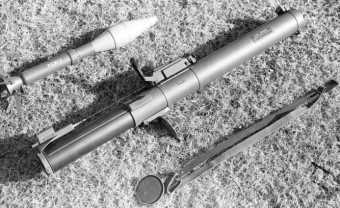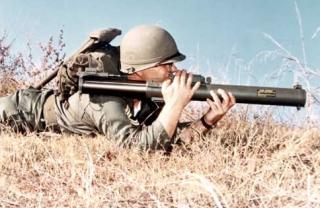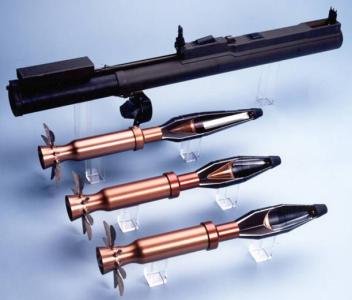Talley 66 mm HEAT Rocket M72 LAW
In 1956, the U.S. Army began to study possible characteristics for a future man-portable Lightweight Anti-Tank Weapon (LAW). Development eventually began in February 1958, based on a design proposed by the Hesse-Eastern Division of Flightex Fabrics, Inc. The first shoulder-firings of LAW occurred in October 1959, and in March 1961 the weapon was classified as standard equipment, designated 66 mm HEAT (High-Explosive Anti-Tank) Rocket M72. The M72 quickly replaced the 3.5-Inch Anti-Tank Rocket M28 as the standard protable anti-armour weapon.
The LAW consisted of the disposable launcher and the rocket in one self-contained package, which weighed (in the original version) 2.3 kg (5.1 lb). The launcher consisted of two tubes (one inside the other), and before firing the inner one telescoped backwards to form the full length (about 90 cm (35 in)) launch tube. The M72 rocket was accelerated by a solid-fueled rocket motor, which burned out before the rocket left the launcher. It was stabilized by six spring-loaded flip-out fins in the tail. The warhead was a 66 mm (2.6 in) hollow-charge warhead, which detonated on impact. The M72 had a maximum range of 1000 m (3300 ft), and effective range against a stationary target was about 10-200 m (33-660 ft).
 |
 | |
| Photos: U.S. Army | ||
| M72 | ||
For LAW training, there was the reusable M190 launcher, which fired the small 35 mm Sub-Caliber Practice Rocket M73. A derivative of the M72 was the 66 mm TPA Incendiary Rocket M74.
In the early 1960s, the M72A1 and M72A2 versions with reliability improvements (including a more powerful rocket motor and better gunsights) were introduced. The final version of the original LAW series, and the last one fielded by the U.S. Army, was the M72A3. This version, which was produced by a US/Norwegian consortium, provided safety upgrades. The M72 LAW system has been exported to several countries, and is still in wide use. The M72A3 is no longer an effective weapon against modern tank armour, but is still a valid low-cost weapon against unarmoured buildings and vehicles. In U.S. Army service, the M72 has been replaced in the late 1980s by the Swedish AT4 anti-tank recoilless rifle (designated M136 in U.S. service).
The current prime contractor for the M72 LAW system is Talley Defense Systems. In the mid-1980s, Talley began to develop the Improved LAW system, which comprised the M72A4, M72A5 and M72A6 rockets. Common features are a new rocket motor, which increases muzzle speed from 150 m/s (500 fps) to 200 m/s (650 fps), and improvements to the launcher for higher accurcy. The difference in the three rockets is the type of warhead. The M72A5 has the same warhead as the M72A3, the M72A4 is optimized for high-penetration, and the M72A6 has lower penetration capability but an enhanced blast effect. This mix of rockets allows to select the most effective warhead for a given combat environment. The M72A7 is a version of the M72A6 with an insensitive munitions warhead, and is used by U.S. Naval special operations forces. Additionally, Talley has received contracts in 2005 to produce about 24000 M72A7 rounds for the U.S. Marine Corps, which intends to use the weapon in urban combat.
 |
| Photo: Talley Defense Systems |
| From top: M72A4, M72A5, M72A6 |
In 2005, Talley and its Norwegian partner NAMMO Raufoss are developing the so-called "Next-Generation LAW" with three new types of rockets. The M72E8 is a derivative of the M72A7 with an FFE (Fire From Enclosure) propulsion system. This would allow to use the weapon in urban combat. The M72E9 is a high-penetration weapon against modern armour, and the M72E10 has a blast/fragmentation warhead for use as an anti-personnel rocket.
 |
| Photo: Talley Defense Systems |
| M72E10 |
Specifications
Note: Data given by several sources show slight variations. Figures given below may therefore be inaccurate!
Data for M72A3 rocket:
| Length | 50.8 cm (20 in) |
| Diameter | 66 mm (2.6 in) |
| Weight | 1 kg (2.2 lb) |
| Speed | 150 m/s (500 fps) |
| Range | 1000 m (3300 ft) |
| Propulsion | Solid-fueled rocket |
| Warhead | High-explosive anti-tank |
Main Sources
[1] GlobalSecurity.org Website
[2] Talley Defense Systems Website
[3] Gary W. Cooke: Gary's U.S. Infantry Weapons Reference Guide
[4] Nicholas Duke: A History of the M72 LAW and Current
Improvement Programs (PowerPoint presentation, 11.2 MB), April 2004
Back to Directory of U.S. Military Rockets and Missiles, Appendix 4
Last Updated: 26 September 2005